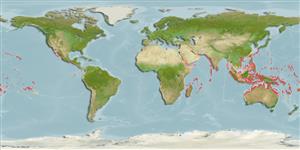Common names from other countries
Environment: milieu / climate zone / depth range / distribution range
экология
морской ассоциированный с рифами; пределы глубины 0 - 20 m (Ref. 9770). Tropical; 30°N - 32°S
Indo-Pacific: Red Sea south to East Africa through Indonesia and northern Australia up to Hawaii and Pitcairn islands; north to southern Japan.
Size / Вес / Возраст
Maturity: Lm ? range ? - ? cm
Max length : 30.0 cm TL самец/пол неопределен; (Ref. 30573)
колючие лучи спинного плавника (общее число) : 3; членистые (мягкие) лучи спинного плавника (общее число) : 22 - 25; колючие лучи анального плавника: 0; членистые (мягкие) лучи анального плавника: 20 - 22. Body orange-brown above; head and belly white; soft dorsal, anal and pectoral fins pale; caudal fin dusky (Ref. 4420).
Occur in shallow outer reefs subject to surge (Ref. 9770, 48637). Commonly found over barren rock or the spur-and-groove zone where there is a mixture of bare rock, rubble, and coral. Juveniles on algae reef (Ref. 48637). Benthopelagic (Ref. 58302). Feed on algae, detritus, mollusks, crustaceans, worms, echinoderms, fishes, sponges, foraminiferans, and eggs. Territorial. Oviparous (Ref. 205). Also taken by drive-in nets (Ref. 9770). Minimum depth reported taken from Ref. 128797.
Life cycle and mating behavior
Maturities | размножение | Spawnings | Egg(s) | Fecundities | личинки
Distinct pairing (Ref. 205).
Matsuura, K., 2001. Balistidae. Triggerfishes. p. 3911-3928. In K.E. Carpenter and V. Niem (eds.) FAO species identification guide for fishery purposes. The living marine resources of the Western Central Pacific. Vol. 6. Bony fishes part 4 (Labridae to Latimeriidae), estuarine crocodiles. FAO, Rome. (Ref. 9770)
Статус Красного Списка МСОП (Ref. 130435)
CITES (Ref. 128078)
Not Evaluated
Угроза для людей
Harmless
Использование человеком
рыболовство: не имеет хозяйственного значения; аквариум: коммерческий
дополнительная информация
инструменты
Специальные отчеты
Скачать в формате XML
ресурсы в Интернет
Estimates based on models
Preferred temperature (Ref.
115969): 24.8 - 29.3, mean 28.3 (based on 2985 cells).
Phylogenetic diversity index (Ref.
82804): PD
50 = 0.5078 [Uniqueness, from 0.5 = low to 2.0 = high].
Bayesian length-weight: a=0.02570 (0.01489 - 0.04438), b=2.92 (2.77 - 3.07), in cm Total Length, based on LWR estimates for this species & (Sub)family-body (Ref.
93245).
Trophic level (Ref.
69278): 3.5 ±0.3 se; based on diet studies.
устойчивость к внешним воздействиям (Ref.
120179): средний (среднего размера), минимальное время удвоения популяции 1.4-4.4 года (Preliminary K or Fecundity.).
Fishing Vulnerability (Ref.
59153): Low vulnerability (20 of 100).
